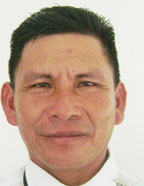What the Toshaos say about…
Interviews and photos by
Alva Solomon
Toshaos attending this year’s National Toshaos Council (NTC) meeting held at the International Convention Centre at Liliendaal were asked for their opinions on this year’s meeting and issues affecting their respective villages.
The following are their answers:
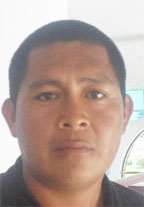 Chavez Francis, Senior Councillor, Quarre Village, Region Nine: ‘I am a newly elected leader for my village and I am happy to be at this year’s conference. I believe the government has good plans for my people and it is nice that we are here to share our views. About 201 people live in my village. A major problem which is affecting my community is [lack of] jobs. A lot of people from my village go over to Brazil to find jobs since there are not much available in my area. Most families at Quarre are engaged in farming. In Brazil, this is about 14 miles overland from Quarre, the men from my village work in factories and on soya farms while the women do domestic work. The men are paid about $700 rais [Brazilian currency] a month which is equal to $70,000. I want to have the opportunity to explain to President Jagdeo the job situation in the area since it is affecting us a lot.’
Chavez Francis, Senior Councillor, Quarre Village, Region Nine: ‘I am a newly elected leader for my village and I am happy to be at this year’s conference. I believe the government has good plans for my people and it is nice that we are here to share our views. About 201 people live in my village. A major problem which is affecting my community is [lack of] jobs. A lot of people from my village go over to Brazil to find jobs since there are not much available in my area. Most families at Quarre are engaged in farming. In Brazil, this is about 14 miles overland from Quarre, the men from my village work in factories and on soya farms while the women do domestic work. The men are paid about $700 rais [Brazilian currency] a month which is equal to $70,000. I want to have the opportunity to explain to President Jagdeo the job situation in the area since it is affecting us a lot.’
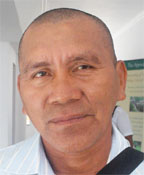 Mc Almont Jones, Senior Councillor, Haiwa, Region Nine: ‘I think it [the NTC meeting] is okay. Some of the problems affecting my village have to do with availability of water and availability of medicine for sick people in the village. At the moment we are not getting water since the hand-pump had a problem recently. So people in the village have to travel about 4 miles to a well to get water. Jobs are a problem also. But most people go to Lethem which is located about 3-5 miles from Haiwa to look for jobs.’
Mc Almont Jones, Senior Councillor, Haiwa, Region Nine: ‘I think it [the NTC meeting] is okay. Some of the problems affecting my village have to do with availability of water and availability of medicine for sick people in the village. At the moment we are not getting water since the hand-pump had a problem recently. So people in the village have to travel about 4 miles to a well to get water. Jobs are a problem also. But most people go to Lethem which is located about 3-5 miles from Haiwa to look for jobs.’
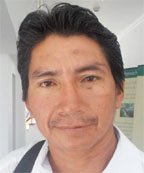 Cletus Johnson, Toshao, Sawariwau, Region Nine: ‘Yes I am glad to be at the NTC meeting this year. It is a good opportunity to interact with the ministers and other Toshaos. My village is located some 80 miles from Lethem. As the other Toshaos may tell you, the problem which mainly affects us is jobs. I hope that the government will do something to help us with this problem. Another thing is the water situation. We depend on a windmill to get water and at the moment we are finding it difficult to have it repaired since this could be costly. A good thing which the government is doing for us at my village is looking into the interest of education for children. There are two primary schools and a nursery school in my village and I think the government plans to renovate the school so this is good for the community.’
Cletus Johnson, Toshao, Sawariwau, Region Nine: ‘Yes I am glad to be at the NTC meeting this year. It is a good opportunity to interact with the ministers and other Toshaos. My village is located some 80 miles from Lethem. As the other Toshaos may tell you, the problem which mainly affects us is jobs. I hope that the government will do something to help us with this problem. Another thing is the water situation. We depend on a windmill to get water and at the moment we are finding it difficult to have it repaired since this could be costly. A good thing which the government is doing for us at my village is looking into the interest of education for children. There are two primary schools and a nursery school in my village and I think the government plans to renovate the school so this is good for the community.’
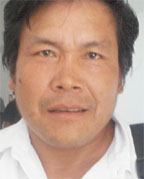 Derek Williams, Toshao, Kamarang, Region Seven: ‘Well I have some issues to raise at the meeting this year and they have to do with birth certificates and land ownership, and I think these two problems need to be recognized more. I think the authorities need to clarify the state land issue since at the moment we have a coastlander who is occupying part of the village land. There are about 220 people in my village and most villagers use creek water which comes down through other villages located on higher ground. The problem with this is that we have to use this same water to cook and wash so when it (the water) reaches us it is in a muddy state. I think a hydro project will help us a lot with this problem. Another problem is overcrowding in the primary school. There are about 73 children who attend the primary school and I think the building needs to be extended since it is too small at the moment.’
Derek Williams, Toshao, Kamarang, Region Seven: ‘Well I have some issues to raise at the meeting this year and they have to do with birth certificates and land ownership, and I think these two problems need to be recognized more. I think the authorities need to clarify the state land issue since at the moment we have a coastlander who is occupying part of the village land. There are about 220 people in my village and most villagers use creek water which comes down through other villages located on higher ground. The problem with this is that we have to use this same water to cook and wash so when it (the water) reaches us it is in a muddy state. I think a hydro project will help us a lot with this problem. Another problem is overcrowding in the primary school. There are about 73 children who attend the primary school and I think the building needs to be extended since it is too small at the moment.’
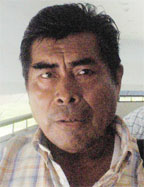 Dhannes Larson, Toshao, Isseneru, Region Seven: ‘It is the first time for me at the NTC conference. The problem which has been affecting my village is pollution caused by miners in the area. But the Guyana Geology and Mines Commission people are dealing with the matter at the moment. In my village there are approximately 260 people and one other problem we have is the shortage of drugs at the health centre in the area. Also we need more teachers at the primary school in the area. There are only two teachers at the school, one is trained and the other would be leaving soon for the teachers training college in Georgetown.’
Dhannes Larson, Toshao, Isseneru, Region Seven: ‘It is the first time for me at the NTC conference. The problem which has been affecting my village is pollution caused by miners in the area. But the Guyana Geology and Mines Commission people are dealing with the matter at the moment. In my village there are approximately 260 people and one other problem we have is the shortage of drugs at the health centre in the area. Also we need more teachers at the primary school in the area. There are only two teachers at the school, one is trained and the other would be leaving soon for the teachers training college in Georgetown.’
Vernon Austin, Toshao, Kaibarupai, Region Eight: ‘The meeting this year is okay. I am able to learn from the other Toshaos of issues affecting them and I am getting answers from the ministers. Approximately 440 people live in my village and at the moment the building which houses the primary school in the area is too small and we recently reached an enrolment figure of 170 pupils. When students leave the primary school at Kaibarupai they go to the secondary school at Paramakatoi. Most people in my village are engaged in farming and gold and diamond mining. A lot of people in the village also plant cassava which is our staple food.’
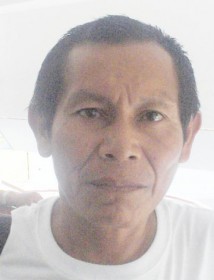 Ernest Daniels, Toshao, Santa Cruz, Region One: ‘I think the conference is good for our villages. At the moment 55 families live at my village of Santa Cruz which is divided into three sections, Little Kanuballi, Big Kanuballi and Santa Cruz Mission. Most people live in Little Kanuballi and these areas are all situated near three main creeks. I think if the government provides us with a small eight horse power engine it would be helpful since, to get to school, pupils have to paddle for about four miles to get to their destination. The problem with the school is that there are only two teachers there, the HM (principal) and another teacher and there are some 92 children attending the primary school there. The primary school needs repairing also. So it would be nice if we get more teachers since the last grade six exam results was not so nice. I think they (government) could also help us with more jobs, and a fish rearing facility or a poultry farm are good alternatives. We have a playground there at Santa Cruz so if we get sports gear from some Good Samaritans it would help to keep the youths in the village occupied.’
Ernest Daniels, Toshao, Santa Cruz, Region One: ‘I think the conference is good for our villages. At the moment 55 families live at my village of Santa Cruz which is divided into three sections, Little Kanuballi, Big Kanuballi and Santa Cruz Mission. Most people live in Little Kanuballi and these areas are all situated near three main creeks. I think if the government provides us with a small eight horse power engine it would be helpful since, to get to school, pupils have to paddle for about four miles to get to their destination. The problem with the school is that there are only two teachers there, the HM (principal) and another teacher and there are some 92 children attending the primary school there. The primary school needs repairing also. So it would be nice if we get more teachers since the last grade six exam results was not so nice. I think they (government) could also help us with more jobs, and a fish rearing facility or a poultry farm are good alternatives. We have a playground there at Santa Cruz so if we get sports gear from some Good Samaritans it would help to keep the youths in the village occupied.’
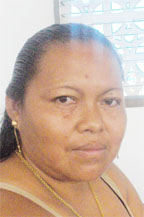 Julie Johnson, Toshao, Micobie, Region Eight: ‘Approximately 300 residents live in my village. When most children finish school they do farming or mining; the boys I am talking about here. The girls do not have nothing much to do but I am thinking about starting a small institute so that they can engage in a skill later in life. I am thinking about opening a kitchen so that the girls could practice home economics. One problem that we have at Micobie is the miners, some of who claim that they have permits to lands when they do not. I hope this matter could be addressed soon.’
Julie Johnson, Toshao, Micobie, Region Eight: ‘Approximately 300 residents live in my village. When most children finish school they do farming or mining; the boys I am talking about here. The girls do not have nothing much to do but I am thinking about starting a small institute so that they can engage in a skill later in life. I am thinking about opening a kitchen so that the girls could practice home economics. One problem that we have at Micobie is the miners, some of who claim that they have permits to lands when they do not. I hope this matter could be addressed soon.’
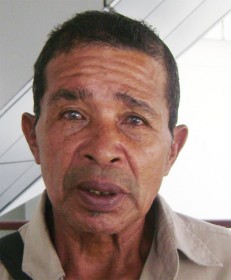 Reuben Gonsalves, Toshao, Red Hill, Region One: ‘I think the conference this year is good. It’s a good opportunity to discuss matters affecting our villages. Approximately 334 people live at Red Hill, which is a village located about 65 miles from Mabaruma. At my village 40% of the people are employed with Amcar, a cabbage processing company in the Barima/Waini area. Other than that most people are engaged in farming, hunting and also fishing. There is only one school in the community, a primary school which has an enrolment total of 107. The problem with the school is staffing and I hope it is fixed soon. In terms of health, we have a health centre in the community but I think it needs to be furnished. I spoke to the relevant minister so I hope something will be done.’
Reuben Gonsalves, Toshao, Red Hill, Region One: ‘I think the conference this year is good. It’s a good opportunity to discuss matters affecting our villages. Approximately 334 people live at Red Hill, which is a village located about 65 miles from Mabaruma. At my village 40% of the people are employed with Amcar, a cabbage processing company in the Barima/Waini area. Other than that most people are engaged in farming, hunting and also fishing. There is only one school in the community, a primary school which has an enrolment total of 107. The problem with the school is staffing and I hope it is fixed soon. In terms of health, we have a health centre in the community but I think it needs to be furnished. I spoke to the relevant minister so I hope something will be done.’
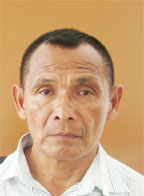 Maurice Henry, Toshao, Kamwatta Village, Region One: ‘I think the meeting is good for now. I was not fully aware of what the Low Carbon Development Strategy was about. But I think myself and other Toshaos understand what it is about and we believe it is useful and will come in helpful as well. About 252 people live in my village and most people are engaged in farming activities. The qualified people coming out of the community mostly take up teaching. The main problem at Kamwatta is finding jobs and most of the younger people do not know how to farm. I say this because it is the only other opportunity available in terms of employment. The government recently provided us with a 215 horse power engine which has assisted us greatly and we are thankful for that.’
Maurice Henry, Toshao, Kamwatta Village, Region One: ‘I think the meeting is good for now. I was not fully aware of what the Low Carbon Development Strategy was about. But I think myself and other Toshaos understand what it is about and we believe it is useful and will come in helpful as well. About 252 people live in my village and most people are engaged in farming activities. The qualified people coming out of the community mostly take up teaching. The main problem at Kamwatta is finding jobs and most of the younger people do not know how to farm. I say this because it is the only other opportunity available in terms of employment. The government recently provided us with a 215 horse power engine which has assisted us greatly and we are thankful for that.’
![]() Reginald Wilson, Toshao, Achawib, Region Nine: ‘The NTC meeting is a good learning experience for me. It is my second term as Toshao for my village. Each term runs for three years. My village is located close to the border with Brazil which is about 12 miles away, and it is located about 100 miles south of Lethem. I am also responsible for a satellite area which is located about 120 miles from Achawib. That area has a population of about 112 and presently at Achawib, there are about 616 people living there. The problems we have at my village are mainly to do with jobs and most people go over to Brazil and work, as it is not far away. The culture in my area is more like Brazilian. Another issue we have to deal with is transportation to get in and out of the village. It is especially difficult during the rainy season. I hope something could be done to fix this.’
Reginald Wilson, Toshao, Achawib, Region Nine: ‘The NTC meeting is a good learning experience for me. It is my second term as Toshao for my village. Each term runs for three years. My village is located close to the border with Brazil which is about 12 miles away, and it is located about 100 miles south of Lethem. I am also responsible for a satellite area which is located about 120 miles from Achawib. That area has a population of about 112 and presently at Achawib, there are about 616 people living there. The problems we have at my village are mainly to do with jobs and most people go over to Brazil and work, as it is not far away. The culture in my area is more like Brazilian. Another issue we have to deal with is transportation to get in and out of the village. It is especially difficult during the rainy season. I hope something could be done to fix this.’

